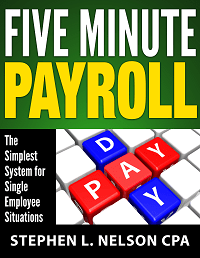
I’ve been hanging out at the bogleheads.org forum recently. And in a discussion about business owner salaries, another forum member asked how one determines whether you save money by bumping your salary in order to make a larger pension contribution even after considering the extra payroll taxes.
This sounds a little complicated but to bring you up to speed, suppose that you own something like an S corporation and can bump your salary by $100,000. You’re contemplating this change because you can then increase your pension fund deduction by $20,000. But here’s the rub: Say that as a result of salary bump you’ll pay additional payroll taxes of $2,900.
How do you know if this trade-off makes financial sense? Are the tax deferral savings that come from the extra $20,000 of pension fund deduction worth paying an extra $2,900 in payroll taxes?
The Quick and Dirty Answer
I want to give you, just in case you’re not a numbers person, the quick and dirty answer to this question. In general, paying more payroll tax in order to get a larger pension fund deduction does not make financial sense. The gambit might save you a bit of money. Or it might cost you a bit. But it’s no silver bullet.
And often, if you do a good accounting, the true savings associated with the pension deduction doesn’t make up for the extra hit of paying the extra payroll taxes. Sorry.
The Detailed Answer You Get From Number Crunching
You can, if you’re comfortable working with Microsoft Excel or a financial calculator, come up with a more precise answer to the pension deduction versus payroll taxes trade-off. Here are the steps:
Step 1: Calculate the future value of your extra pension fund deduction
To do this, use the Excel FV function to make this calculation:
=FV(InterestRate,YearsCompounding,0,-ExtraDeduction)
For example, if you’re looking at saving an extra $20,000 this year and will then let this investment compound at 6% for 20 years before you retire, you use this formula:
=FV(6%,20,0,-20000)
The formula returns the result $64,143. (Note that if you’re going to use this formula, copying and pasting the formula from this page directly into an Excel worksheet cell will reduce the chance you enter a typo.)
Step 2: Calculate the after-tax pension deduction future value
After you calculate the future value of your extra pension deduction, you need to first come up with an estimate as to the future taxes, and then find the net, after-taxes pension withdrawal amount you’ll have. This is the step people usually forget (perhaps because it’s so far into the future). But the step is critical. Without this calculation, any analysis ignores the reality that the pension deduction doesn’t necessarily save you taxes. The deduction may only defer, or delay, your taxes.
Federal income tax rates run from 0% to 39.6%. And you would want to consider state income tax rates, too. But let’s say for sake of illustration that the combined tax rate at time of withdrawal will equal 25%.
In 2013, the 25% federal rate applies to couples with taxable income ranging from slightly over $70,000 to just under $150,000. For single taxpayers, the 25% federal rate applies to income ranging from just under $40,000 to nearly $90,000.
I would guess the 25% tax rate (and surely not the lower rates) would apply to many people considering this pension deduction versus payroll taxes trade-off.
To calculate the taxes paid when the pension money is ultimately withdrawn in, say, 20 years, multiply the 25% rate by the $64,143 future value of your deduction to get $16,036 (your tax on this income). Then subtract this value from the pretax $64,143 and you get the after-taxes value of $48,107. At this point, the dust has settled on the pension deduction taxes. The piper has been paid.
Step 3: Calculate how much you’ll be able to save into a tax-advantaged alternative
Your next step in the analysis is to calculate how much you could save into an alternative, tax advantaged investment. And here’s where you need to be careful. In our example, you have that $20,000 of “not yet taxed” money available. So that’s good. But remember that there’s also the (per our example) maybe $2,900 of payroll taxes you’ll save.
You’ll also have to pay income taxes on the $20,000 and, actually, on about half of the payroll taxes. If the combined federal and state tax rate is 33%, you would pay 33% tax on roughly $21,500. Or very roughly about $7,000.
So—and this is the immediate, very obvious effect of the tax deferral benefit—you’re only going to be saving $15,900 into the tax-advantaged alternative investment.
Step 4: Calculate the future value of the tax-advantaged alternative
To do this, use the Excel FV function to make this calculation:
=FV(InterestRate,YearsCompounding,0,-AlternativeInvestment)
In the example used in this discussion, you’ll be able to save $15,900. So that part is easy.
The tricky part is adjusting the interest rate for any taxes paid along the way. For example, if you can earn 6% pretax but will pay a 33% income tax rate, you won’t on this alternative compound your investment at 6%. You will compound your investment at 4%. You lose 2% of your 6% return because of the income taxes. (I calculate this as 33% of 6%.)
But I think you can, and should, assume that you can achieve a basically tax-free compounding rate on your alternative. I grant you this seems very, well, aggressive. But if you invest in an index fund or index ETF, the tax burden should in the sort of example that we’re using amounts to an immaterial rounding error.
So here’s our formula:
=FV(6%,20,0,-15900)
It returns the result $50,993. As noted earlier, if you’re going to use this formula, copying and pasting the formula from this page directly into an Excel worksheet cell will reduce the chance you enter a typo. Also, note that if you think it’s simply preposterous to ignore the income taxes in the compounding, you need to adjust the “InterestRate” input in the formula.
Step 5: Honestly Assess the Taxes on the Tax-advantaged Alternative
The next to final step in this little analysis is to estimate any income taxes on the future value you accumulate in the tax advantaged alternative.
Probably, the safest assumption predicts you’ll pay a long-term capital gains rate (currently the federal rate is 15%) on the gain. The gain equals, in our example, the difference between the $50,993 end with and the $15,900 you started with, or $5,264 in this example.
But do note that you may not ever have to pay this tax. A variety of plausible scenarios exist where you sidestep this tax completely. Unlike balances in a retirement account, for example, you won’t automatically be forced to liquidate your tax advantaged alternative. You might also find yourself paying not the 15% capital gains tax rate but the 0% capital gains tax rate (perhaps because of a lower income or because of capital loss carryforwards). You might decide to gift the balance to a charity. Or, and this is morbid, but your death or your spouse’s death may cause some or all of the basis to be stepped up to fair market value.
All that said, however, I think you assume a 15% capital gains tax rate. But just keep in mind that plausible scenarios exist where the rate might be lower or might even be zero.
Step 6: Calculate the after-tax tax advantaged alternative value and compare to the after-tax pension value
The last step you take is to calculate the after-tax tax-advantaged alternative value by subtracting $5,264 from $50,993. You then compare the result, $45,729, to the after-tax pension value, which is in this example $48,107.
The higher value wins. And in this case, you do end up with about $2,500 more using the bigger pension deduction route. But as I said early on, this is surely no big win, right?
Farther into the Weeds
But let me step a bit farther into the weeds on the topic.
While the preceding example shows a bigger pension deduction winning by a nose, the outcomes are very sensitive to changes in the payroll tax burden. If you live in a state where you will pay a state-level payroll tax on the extra salary required to pay a bigger pension fund contribution, that extra tax may easily tip the scales.
If you will pay not the 2.9% Medicare tax but the 15.3% Social Security and Medicare tax in order to get a larger pension deduction, you probably can’t make the numbers support the case for a larger pension fund contribution.
For example, the combined Social Security and Medicare tax rate on earnings up to $113,700 equals 15.3%. And if you currently pay yourself $40,000 (the average S corporation shareholder-employee salary) but are considering paying yourself $120,000 in order to max out something like a solo 401(k), the numbers simply won’t work. You will pay roughly an extra $11,000 in payroll taxes for a deferral benefit that, as you’ve seen from earlier example, just isn’t that valuable.
Another point: You want to experiment with the marginal tax rate during your drawn-down, retirement years. That rate can greatly affect your analysis. For example, if your marginal tax rate in retirement isn’t 25% but 28%, in an example like the one provided above that bump into the next tax bracket eliminates the tax deferral advantage.
Finally, consider the possibility of something like an early withdrawal penalty along the path to retirement. Say you at some point along the way need money for an unbelievable investment opportunity (like buying a business or some unique real estate deal). Or say some family emergency means you must draw a large sum from your nest egg. Money outside of a pension account may allow you to avoid the 10% early withdrawal penalty. And that would also tip the scales toward the tax advantaged rather than the tax deferred investment option.
If you’d like a spreadsheet version of the calculations I’ve just discussed to play around with this a bit yourself, there’s one I’ve made here.
A Quick Plug for Our $20 Five Minute Payroll eBook
You maybe don’t know this if you haven’t poked around this blog a bit, but in another post (see here if you’re interested) we talk about how you can shortcut the work of payroll in one-employee situations.
Readers have regularly asked for a fuller ebook that goes into all the details of this payroll approach, however. (We call the approach the “Five Minute Payroll” system.) Accordingly, we created a $20 ebook, “Five Minute Payroll” that provides these more precise instructions, fully completed example IRS forms, and then also nearly complete IRS forms to which an employer adds the business name, address and EIN.
The “Five Minute Payroll” ebook gives you a really cheap, super fast way to do simple cookie-cutter payroll for most one-employee S Corporations using base salary amounts of $10,000 a quarter or $16,000 a quarter. (These quarterly amounts, which mean annual payrolls for a shareholder employee of $40,000 or $64,000, should work for just about everyone.)
If you’re interested our $20 ebook, you can use this button:
Money Back Guarantee: As with all of our monographs and ebooks, of course, our products come with a money back guarantee. If you don’t think our ebook is worth it, just let us know (email works best) and we’ll refund your purchase price.
By the way, we do promise the monograph delivers great value. Once you learn our “Five Minute Payroll” system you can skip paying some outside payroll service $500 or $1000 a year. And you’ll also reduce your payroll return preparation to, oh, about five minutes a year…

My beginner standing is long gone now, lol.
Marvelous, what a weblog it is! This web site provides helpful facts
to us, keep it up.